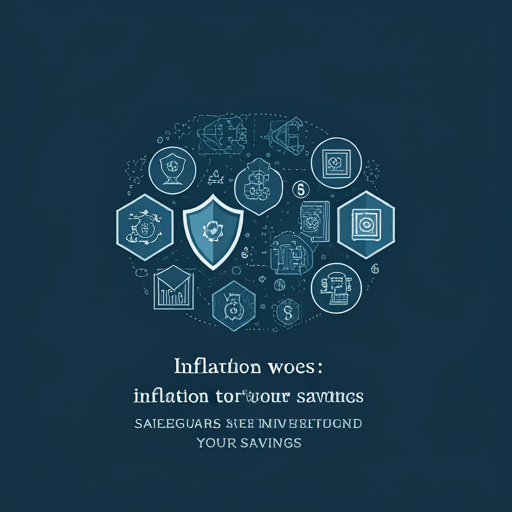Introduction to Inflation and Its Impact on Savings
Understanding Inflation: Causes and Effects
Inflation represents the rate at which the general level of prices for goods and services rises, eroding purchasing power. Consequently, as inflation increases, the value of savings diminishes. This phenomenon can significantly impact individuals’ financial stability. Understanding these dynamics is crucial. Inflation affects everyone.
The Historical Context of Inflation and Savings
Historically, inflation has fluctuated due to various economic factors, including supply shocks and monetary policy changes. These fluctuations have often led to significant impacts on savings. For instance, during the 1970s, high inflation rates eroded the real value of savings accounts. Many individuals lost purchasing power. Understanding this history is essential. It shapes current financial strategies.
The Role of Cryptocurrency in Combating Inflation
How Cryptocurrencies Function as a Hedge Against Inflation
Cryptocurrencies, particulwrly Bitcoin, are often viewed as a hedge against inflation due to their limited supply. This scarcity contrasts with fiat currencies, which can be printed in unlimited quantities. As rising prices rises, investors may flock to cryptocurrencies. They seek to preserve value. This trend is notewogthy.
Case Studies: Successful Use of Crypto During Inflationary Periods
During hyperinflation in Venezuela, many citizens turned to Bitcoin as a means of preserving wealth. This shift demonstrated the cryptocurrency’s utility in unstable economies. Additionally, inward Turkey, rising inflation rates led to increased interest in digital assets. People sought alternatives to traditional banking. This trend is significant.
Diversifying Your Investment Portfolio
The Importance of Asset Diversification
Asset diversification is crucial for mitigating risk in investment portfolios. By spreading investments across various asset classes, individuals can reduce the impact of market volatility. Common asset classes include stocks, bonds, real estate, and cryptocurrencies. This strategy enhances potential returns. It also protects against significant losses. Diversification is a smart approach.
Incorporating Cryptocurrencies into Your Portfolio
Incorporating cryptocurrencies into an investment portfolio can enhance diversification. By allocating a portion of assets to digital currencies, he can potentially increase returns. This approach also mitigates risks associated with traditional markets. Many investors are exploring this option. It is a growing trend.
Stablecoins: A Safe Haven in Volatile Markets
What Are Stablecoins and How Do They Work?
Stablecoins are digital currencies designed to maintain a stable value, typically pegged to fiat currencies like the US dollar. This stability makes them attractive during market volatility. He can use stablecoins to preserve capital. They provide liquidity and ease of transactions. Many investors find them reliable.
Benefits and Risks of Using Stablecoins
Stablecoins offer several benefits, including price stability and ease of use in transactions. They can serve as a safe haven during market fluctuations. However, risks exist, such as regulatory scrutiny and potential loss of peg. He must consider these factors carefully. Understanding both sides is essential.
Investing in Precious Metals Alongside Crypto
The Historical Value of Gold and Silver
Gold and silver have historically served as stores of value and mediums of exchange. Their intrinsic properties make them desirable during economic uncertainty. Many investors view these metals as a hedge against inflation. They provide stability in turbulent markets. Precious metals are time-tested assets.
Combining Precious Metals with Cryptocurrency Investments
Combining precious metals with cryptocurrency investments can enhance portfolio diversification. This strategy allows for risk mitigation during market volatility. Precious metals provide stability, while cryptocurrencies offer growth potential. He can balance his investments effectively. This approach is increasingly popular among savvy investors.
Utilizing Decentralized Finance (DeFi) Solutions
What is DeFi and How Does It Work?
Decentralized Finance (DeFi) refers to financial services built on blockchain technology, enabling peer-to-peer transactions without intermediaries. This system allows users to lend, borrow, and trade assets directly. He can access various DeFi protocols for diverse financial activities. These platforms often offer higher yields. Understanding DeFi is essential for modern investors.
DeFi Strategies for Earning Passive Income
DeFi offers various strategies for earning passive income, such as yield farming and liquidity provision. By participating in these activities, he can earn interest on his crypto assetw. These methods often yield higher returns than traditional savings. Understanding the risks is crucial. Knowledge is power in investing.
Building an Emergency Fund with Crypto Assets
Why an Emergency Fund is Essential
An emergency fund is crucial for financial security, providing a safety net during unforeseen circumstances. By allocating a portion of crypto assets to this fund, he can maintain liquidity while potentially earning returns. This strategy balances risk and accessibility. It is a prudent approach. Financial stability is vital.
How to Create a Crypto-Based Emergency Fund
To create a crypto-based emergency fund, he should first determine the amount needed for unexpected expenses. Next, he can allocate a portion of his cryptocurrency holdings to a secure wallet. This ensures liquidity while maintaining potential growth. Regular contributions can enhance the fund’s stability. Consistency is key for success.
Conclusion: Taking Action Against Inflation
Summarizing Key Strategies for Safeguarding Savings
To safeguard savings against inflation, he should consider diversifying investments across various asset classes. Incorporating cryptocurrencies and precious metals can enhance portfolio resilience. Additionally, establishing an emergency fund is essential for financial security. This strategy provides peace of mind. Taking proactive steps is crucial for success.
Encouraging Proactive Financial Management
Proactive financial management is essential for navigating economic uncertainty. By regularly reviewing his investment strategies, he can adapt to changing market conditions. This approach helps mitigate risks associated with inflation. Staying informed is vital. Knowledge empowers better financial decisions.
